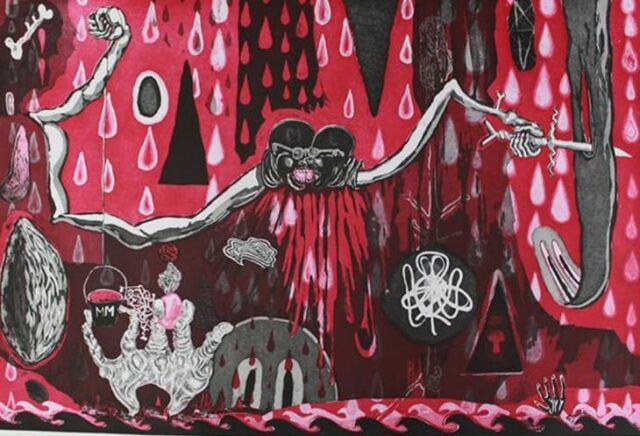Taken aback, that is exactly how I would describe my reaction to seeing A Sweet Hell by Trenton Doyle Hancock for the first time. In many ways, it reminded me of a nightmare from the deep dark corners of someone’s mind, terrifying figures swords and all. Serving as a backdrop to the nightmarish scene was a setting that is eerily reminiscent of Valentine’s Day with pinks, reds, and whites creating a loving mood with the only things missing being hearts and a Cupid. The nightmarish skeletal creatures with swords in a Valentines Day, loving setting is exactly the juxtaposition that one enters and experiences in the art of Hancock.
A Sweet Hell was created in 2010 as Hancock completed a residency at Singapore Tyler Art Print Institute that culminated in a solo exhibition, A Day Ahead, A Head A Day. In this exhibit, and throughout all of his works, the viewer is transported to Trenton Doyle Hancock’s mythological world, a visual labyrinth packed with biomorphic forms of bones, emancipated bodies, and sexual orifices oozing pink goo. Hancock’s self-invented epic combines the poetic ferocity of William Blake and the apocalyptic vision of Hieronymus Bosch to create characters of his ongoing visual battle between the forces of good represented by “Mounds” in their color filled world, and the evil skeletal “Vegans” who live underground in a world of black and white. I can only guess that the black skeletal creatures A Sweet Hell are the “Vegans” as they seem evil and the fact that they could have been transported straight from my nightmares just confirms it. It seems as though in this work there are no “Mounds” present which Hancock describes as half human half plant mutants. From the looks of it, the work is telling the story of the “Vegans” rampaging a world of color. It appears as though the “Vegan” skeletal creatures are kissing each other or attempting to french kiss. This act of love is just another form of juxtaposition coming from within the work as it is performed by the so-called evil character. This juxtaposition speaks to the idea that there are ranges in all things. Things are rarely just black and white and there is often a gray area in between, the same can be said for good and evil. There is a range of both as there is rarely a pure evil and a pure good and it is for the viewer to identify where in the range people and objects fall. The use of juxtaposition within the work also facilitates the opportunity for comparison and the recognition of similarities- particularly between good and evil. Both are just morals based upon opinions and perceptions of situations and what formed those situations.
While my first reaction was one of shock, I think that more importantly, the work created a moment of pause and contemplation. It is a pause that allows the viewer the opportunity to begin to compare and recognize the effects of juxtaposition that highlight the larger themes of the work, such as good and evil.
Trenton Doyle Hancock was born in 1974 in Oklahoma City, OK. Raised in Paris, Texas, Hancock earned his BFA from Texas A&M University, Commerce, and his MFA from the Tyler School of Art at Temple University, Philadelphia.
– Oliver Poduschnick ’25
Sources:
https://www.stpi.com.sg/exhibitions/trenton-doyle-hancock-a-day-ahead-a-head-a-day/
https://art21.org/read/trenton-doyle-hancock-storytelling-characters-and-colors/

